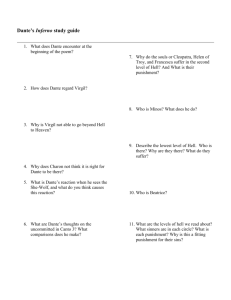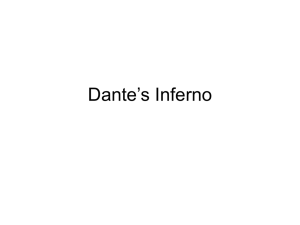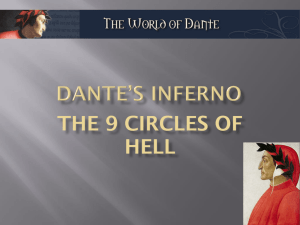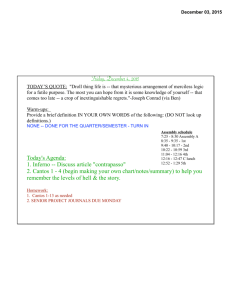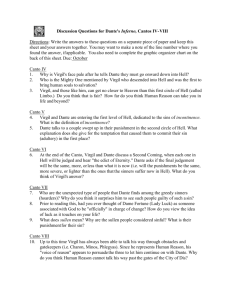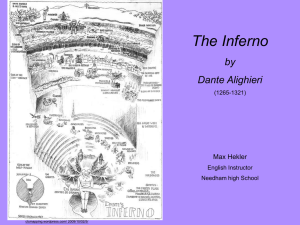Downloadable PowerPoint Slides
advertisement
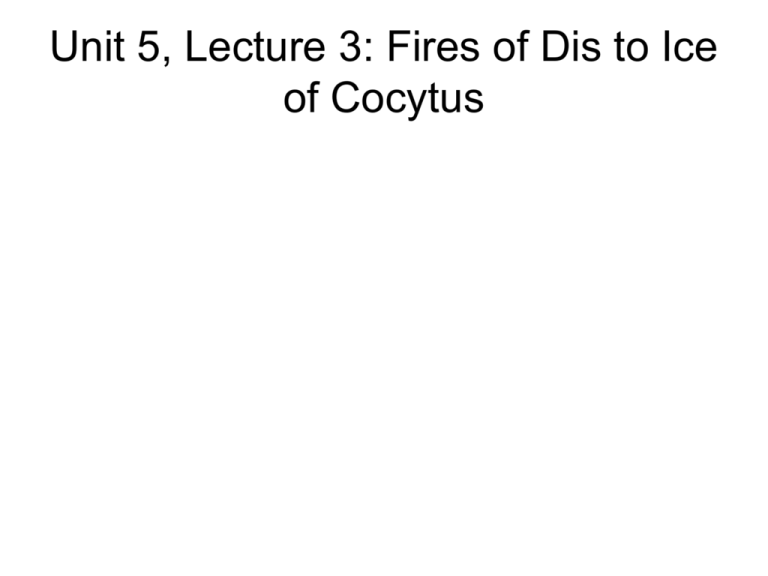
Unit 5, Lecture 3: Fires of Dis to Ice of Cocytus To the City of Dis •Cantos v-viii: Virgil guides Dante through the circles of the gluttonous, the misers & spendthrifts, and across the river Styx where the wrathful and sullen are immersed •Canto IX: Despair and the outskirts of Dis –Literal Story: •Refused entrance and mocked by the harpies on the wall •Virgil covers up his eyes against the appearance of Medusa •The poet then calls attention to an allegorical meaning: –O you possessed of sturdy intellects/Observe the teaching that is hidden here/beneath the veil of verses so obscure.” –Allegorical Meaning (Norton 1297) •The greatest sin for Medieval Christendom is “stony-heartedness.” •This hard impenitent heart is created by despair-that one is beyond forgiveness (the condition of those in hell) •Medusa stands for the hardening, petrifying effect of this despair. Dis=Lower Hell: Violence and Fraud • The violent against truth (Heresy) – Literal Story • Farinata degli Uberti’s mighty pride: “as if he had tremendous scorn for hell” • Pride underlines by use of words such as “scorn,” “disdain” and actions such as ignoring his fellow heretic, Cavalcante de Calvalcanti (fr. of Dante’s best friend) – Allegorical meaning: • Intellectual pride and scorn of others may spring from same root. Transition to Lower Hell (1): the Violent Proper (Cantos xii-xvii) • 7th-”three ring circle” for the violent—against neighbor, against self, and against God. • Violent against self (xiii). – Literal Story: • The Suicide Woods and Pier della Vigna: “We once were men and now are arid stumps” (xiii.37) • His “disdainful flight” from undeserved dishonor though death • His description of the last judgment: the bodies will hang from the “stump” – allegorical Meaning • Suicide as a form of sterility: instead of producing the fruit of the vine: Pier della Vigna produces the blood of death • The state of the suicide is less a punishment of sin than a revelation of the sin. The eternal separation of soul and the rejected body is simply the expression of the suicide’s decision. • Violent against God: nature – Literal Story: Dante’s unforgettable encounter with Brunetto Latini who “taught me how man makes himself eternal” (85) – Allegorical meaning: Transition to Lower Hell (1)” the Violent Proper (Cantos xii-xvii) • A Gustave Dore painting Lower Hell 2: Fraud: Brief Notes on xviii-xxix • 8th circle begins another division: that of “simple” fraud and is divided into 10 “pouches” • Cantos xxi-xxii are called the “gargoyle” cantos because they are like the grotesque gargoyles in a cathedral • In Canto xxiv-xxv, we see a kind of ongoing “identity theft” as thieves-turned-snakes steal back their human form from other thieves who, in turn, are transformed into serpents. • A remarkable encounter with Ulysses in the 7th pouch of “fraudulent counselors”’ notice as with Ser Brunetto Latini, we have again the paradox of the “inspiring” sinner as we focus on Odysseus’s last voyage: – Consider well the seed that gave you birth: You were not made to live your lives as brutes, But to be followers of worth and knowledge (xxvi.120) Lower Hell (2): Fraud: Brief Notes on xvii-xxix • Paintings “Hell Freezing Over” Cantos xxxixxxiv • • To take a line from Robert Frost, Dante’s Inferno ends not in “fire” but in “ice.” In the frozen river of Cocytus, traitors arranged in a kind of “descending order of coldness” – Caina (after “Cain”): traitors to kin are immersed halfway in ice; heads bent down (xxxii) – Antenora (after Trojan traitor): traitors to homeland or party (xxxii-xxxiii) – Ptolomea (after Ptolomy): Traitors to guests buried with eyes facing up and tears frozen (xxxiii) – Judecca (after Judas): containing those who betrayed masters • Literal Story: – Count Ugolino chewing the head of archbishop Ruggieri – A traitor recites a pathos-laden story of his own betrayal and watching the death of children and grandchildren Gaddo, throwing himself, outstretched down at my feet/implored me: “Father why do you not help me?” and there he died. . . (xxxiii 67-71) – Satan as three-headed monster, chewing three sinners. (Cassius, Brutus, and Judas—note, again, this latest [and most grotesque] coming together of classical and Christian culture) His wings freeze hell Yep Hell did freeze over! Allegorical Significance of Cocytus • Note that images of “devouring” and “coldness” dominate the final cantos. • Satan as a parody of the creative love of the Trinity. – Just as the “warmth” of God made the world, the beating of wings freezes it. – His 3 “slavering” and devouring heads parody the 3 “giving” persons of the Trinity • Frozen tears of frustrated self-will as parody of “warm” tears of honest repentance • As in Augustine, wrongdoing is viewed as a “perverse imitation” of God • This full “unmasking” of evil becomes the means and motive for seeking redemption, as Virgil and Dante “climb” Satan’s legs to seek the redeeming pains of purgatory.

